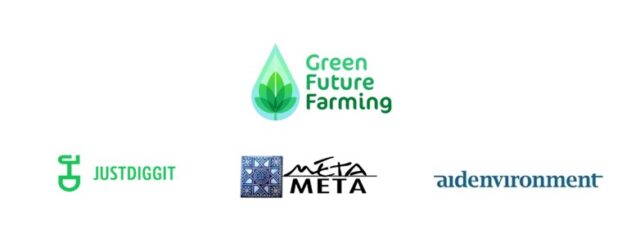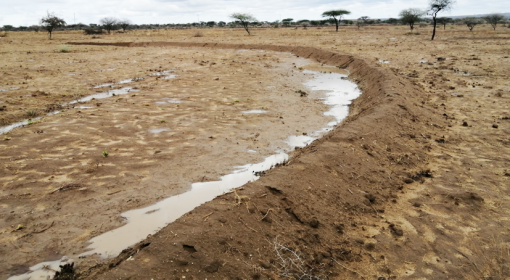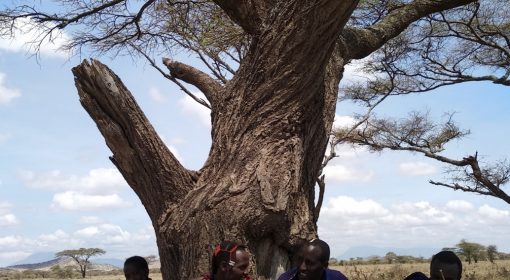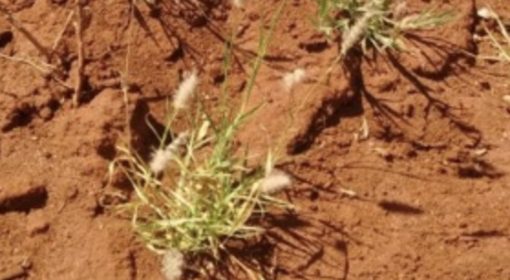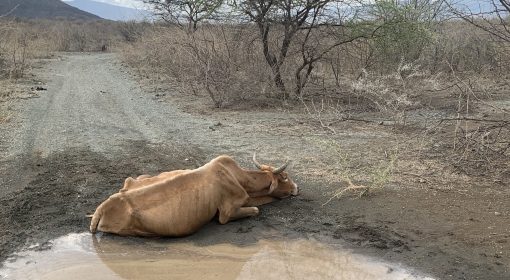A pastoral community finding ways to combat the biggest threats of climate change.
By Ishani Sonak (MetaMeta) and Femke van Woesik (MetaMeta), with inputs from Esmee Mulder (MetaMeta)
The Horn of Africa is facing the biggest drought in forty years. It has led to a humanitarian crisis with food and water insecurity. Maasai communities in Kenya are one of many severely hit by this climate induced crisis. Through citations from Maasai members themselves, this blog discusses their perception on this crisis and their way to combat it complemented with satellite data analysis. These perceptions were collected in Maa language and translated to English.
“Droughts are common in this region but this time five consecutive rainy seasons have failed us (since late 2020). The topsoil erodes forming dust devils when the wind blows. There is no water in the water points for us, our livestock or even wildlife. If by god’s grace, there is a little rainfall, the rainwater runs off eroding the top soil as there is no grass to hold the moisture intact.” – Young Maasai pastoralist near Amboseli National Park.
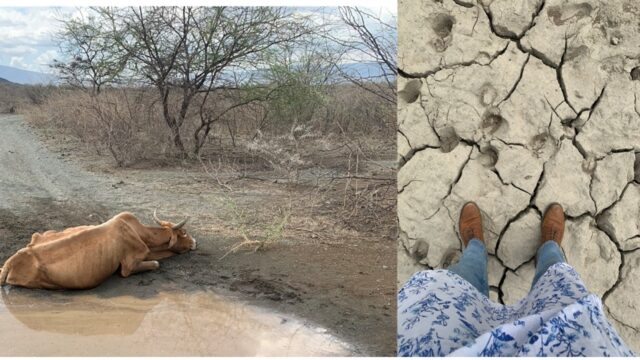
For a pastoral community, these are dire circumstances. Many of the Maasai pastoralists have lost more than half of their livestock due to the drought. Dead livestock and wildlife have become a common sight in the region (Photo 1). Though livestock mobility is a common livelihood strategy for the Maasai, due to the extent of this drought, land privatization, and human accelerated land degradation, they have been forced to move much longer distances in search of water and healthy pastures than before.
Semi-arid rangeland ecosystems inhabited by Maasai pastoralists experience a bimodal precipitation regime due to its proximity to the equator and seasonal movement of Inter Tropical Convergence Zone (ITCZ). The long rainy season occurs from March to May, when ITCZ moves southwards towards the equator and short rainy seasons from October to December, when ITCZ moves away but its influence can still be felt bringing less intense rain. Rainfall is often localised and unpredictable and can vary greatly from year to year. Indian Ocean Dipole (IOD) and the El Niño-Southern Oscillation (ENSO) exert a dominant influence on inter annual climatic variability in the region (Palmer et al., 2023; Rao et al., 2011). Both these climate patterns disrupt the normal rainfall regime leading to prolonged and extensive drought conditions such as in years 2005-06, 2009-10, 2016-17 and 2020-23 as well as extreme events such as flooding in 2018 (Githumbi et al., 2018; Palmer et al., 2023; Winkler et al., 2017). Interestingly, this has severe implications on the livelihood of the Maasai due to lack of pasture availability in the region. Normalised Differential Vegetation Index (NDVI) from MODIS satellite is a well trusted tool to analyse the greenness in any region at 250 meter resolution. Upon analysing this data for the region (Amboseli and South Rift Valley, Kenya), average NDVI is seen to be increasing linearly from the past 22 years since 2000. However, the lowest NDVI was observed in years when the region was experiencing drought (2009, 2016-2017) and an exponential increase when the region saw wet years (2018).
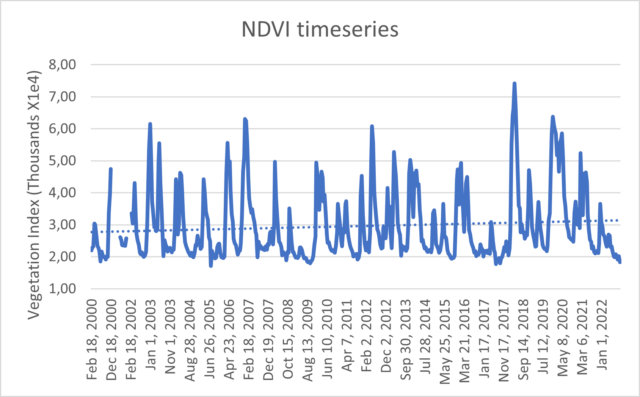
Changes in the land cover can significantly impact the climate through changes in the energy balance (See article for detailed explanation on Managing Microclimate). Evapotranspiration and/or soil moisture due to increase in vegetation cover can buffer temperature and vice versa. Therefore, correspondingly, the temperature (Land Surface Temperature (LST)) is highest when the region experiences drought and extremely low NDVI values (See graph for NDVI and day LST). 2018 was considered to be one of the wettest years and then the temperature was lower than normal. Though 2018 is an anomaly (unprecedented rainfall and flooding), such extreme years manipulate the averages. Also, increase in average NDVI can be explained by the increase in the number of open trees in the region.
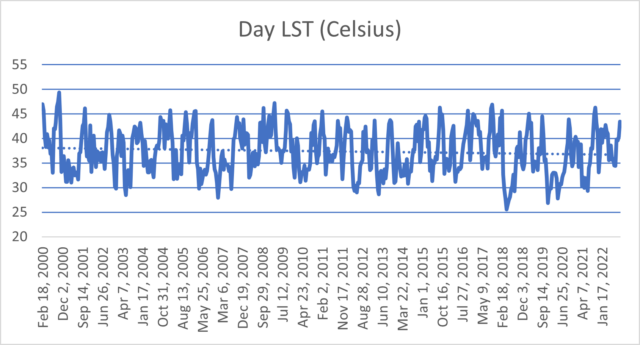
On the contrary, the perceptions of the Maasai community regarding their pastures and temperature differ from the observations derived from satellite data.
“The grasses have been depleting over the years and trees have been increasing. Frequency of drought has been increasing too. The last drought we saw was in 2009, followed by 2015-2016 and now 2020 to 2022. As a result, several species of grasses are disappearing. Even when there is grass somewhere, it’s of no use to us without any water. It goes hand in hand. Rains must come for us to survive on our parched land.” – Maasai community leader in South Rift Valley, Kenya
Such existing difference between observed and perceived trends threatens the sustainability of any adaptation and mitigation measures. Moreover, the Maasai in parts of Southern Kenya face a gigantic challenge: Land Degradation. Also, it is suspected that prolonged droughts may accelerate degradation and threaten the system’s potential to bounce back. The economic loss due to rangeland degradation in Kenya, calculated through losses in milk and meat production, as well as in livestock live weight is about 80 million USD annually (Mulinge et al, 2015).
“Earlier we used to be able to look at a constellation and its position in the sky and predict the rains. Accordingly, we would plan selling of our livestock. However, now that knowledge has failed us and we are left confused what to do. We need to rise together as a community to help ourselves in these times.” – Maasai elderly in Olgulului Olalarashi Group Ranch (OOGR), near Amboseli.
To adapt to climate change and continue the tradition of Maasai resilience of turning the arid, less fertile lands productive by converting solar energy, water and grass into milk, meat and more, the Maasai have come together. Justdiggit, as part of the Green Future Farming project funded by IKEA, together with the local partner SORALO, aims to naturally restore degraded communal rangelands through a community lead approach. It is a simple, scalable, nature-based land management technique that empowers the Maasai pastoralists to stop and reverse land degradation and additionally manage local climate. The idea is simple: slow down rainwater flow over land and capture it, increase water infiltration, and improve soil moisture. As a result, the water balance and soil fertility will improve and grass seeds will get a chance to sprout: regreening and enhanced cooling!
In Imbrika Valley at Oldorko in the south rift escarpment of Kenya, due to insufficient vegetation and gully formation, surface runoff and the siltation of water pans in the region have increased. At the onset of the rainy season (Early November 2022), the community members from the surrounding region started excavating a water pan in hope to collect rainwater. By early December, the region saw 3 or 4 days of bare minimum rainfall, but the water pan was full of water accessible for the livestock (Photo 2). However, a community elder pointed out that the excavated silt laying around the pan needs to be removed to prevent it from re-silting the pan.
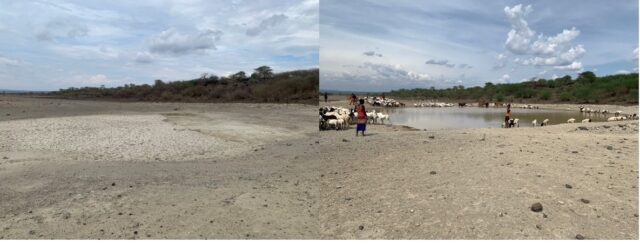
Further downstream in the same communal land, the community started digging soil bunds in an area of 20 acres with the expectation of regeneration of grasses, water retention and cooler temperature. Digging of soil bunds softens the desiccated top layer and harvests rainwater that would otherwise run downhill. Due to improved water infiltration and soil moisture levels, the grasses sown in the area get a better chance to sprout, resulting in the restoration of the area. See this blog to understand how bunds can lead to regreening and change local climate. The bund can be seen in Photo 3.

I have lived here since I was born 50 years ago. Usually, I graze my herd here but now because of the drought my cows are grazing far away. Over the years, grasses have been difficult to find due to reduced rainfall. The land is so degraded that even when it rains, gullies are formed and gushing water washes the top soil taking grass seeds with it. Digging these bunds downstream will help water to stay in the bunds and percolate slowly. This will lead to increase in soil moisture which will help in regeneration of nutritional grass but also cool down the temperature. Retention of water in the soil with enough vegetation will further induce rain. It is the only way to ensure survival of my livestock, my walking ATM.” – Kenyatta, Community leader of the area.
“However, there is one challenge to these bunds. If there are heavy rains, water may come downstream with greater velocity that may break the bunds (See Photo 4).” – Community leader of the project. Therefore, the community, along with SORALO chose a site upstream to build stone lines and rainwater harvesting structures (over 15 acres) reseeded with grass seeds (see Photo 4). These specific interventions may decrease the velocity of water, stimulate infiltration and soil conservation. “We hope that this will save the bunds being destroyed and reduce the amount of silt flowing into the water pans excavated downstream. However, we have our concerns (See Photo 4)!” – Community team leader of the project.

Apart from land restoration, the community members received a small incentive (162 Kenyan Shilling or 1.3 USD) for digging one bund irrespective of hard or soft soil. Mostly these members included women as men were away with the herd in search of pastures. “We are here for work and money. Due to these interventions, grasses will grow over a period of time and sustain us in the long run but this amount of money earned from digging helps us enormously in these gruesome times.” – Young woman (26) involved in digging of bunds. The aim is to incentivise participation in decision making and implementation. This technique of incentivising may or may not prove the best in the long run. However, such projects work along a learning curve.
Preliminary results after a short spell of rain have bolstered community’s hope. “The scenery of the region has changed. There is a lot of water in the pans. Area around the bunds seem to have collected some water. The grasses are emerging. It is pleasant to walk in that region. Our livestock likes to flock around in that region over others. If this project realises its full potential we could combat the challenges of drought and manage our local climate” –Maasai school teacher of the region (See Photo 5).
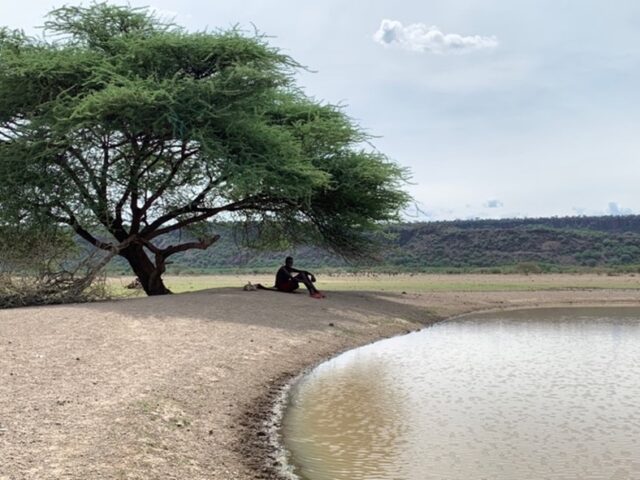
The interventions will be fully realised with sufficient rainfall (of course!) and if needed, necessary alterations. Largely, the community has embraced the restoration efforts, as no negative side effects from the interventions have been observed. Moreover, the community expressed the need for more such restoration projects in the area. However, there is apprehension within the community regarding the continuation of interventions like digging bunds and trenches once the project implementers withdraw, posing a threat to the long-term sustainability of the restoration projects. To address this challenge, it is essential to establish community ownership. This can be achieved by sustaining participatory engagements such as involving them in decision making but also monitoring efforts, offering opportunities for capacity building to understand complex mechanisms, and enhancing direct and indirect socio-cultural and economic benefits. Setting realistic expectations is also paramount to establish long-term communal management of the landscape. Such measures will not only encourage community ownership but also ensure socio-ecological resilience. Climate variability will be a challenge but this can maximise the positive outcomes of the restoration efforts and also prepare the community for impending climate extremes.
